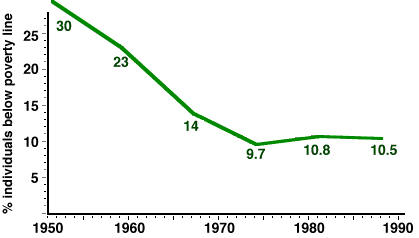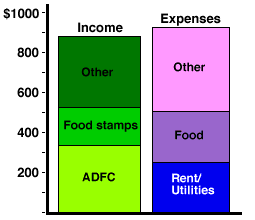

In fact, from 1950 to 1980, poverty declined by 2/3:

The graph, based on figures from Christopher Jencks' Rethinking Social Policy, shows the percentage of individuals under the poverty line, corrected to use a better inflation index than the original Census figures, and to take the value of government benefits into account. The poverty line is the government's attempt to define the income level below which a family is poor. In 1990 it was $10,419 for a family of three; in 1994, $11,821. Any such number is of course arbitrary-- in effect, it was set to pick out the poorest fifth of the population in 1964. Once a level is chosen, however, comparisons between years or sectors of the population are informative.
Why did the poverty rate go down? Mostly, due to the incredible postwar economic boom: a nearly 30-year period in which productivity rates rose 2.8% a year, and in which that productivity growth translated into extra income for people at all economic levels.
Since 1973 productivity has risen at less than 1% a year, and the increase is no longer distributed across the board: most of it has gone to the rich. During the '80s, the wealthiest 1% of families saw their income double; the families in the middle saw their incomes rise about 5% (for the whole decade); low-income families saw their income drop 10%.
The far-right claim that government action doesn't benefit the poor, or makes them worse off, just doesn't accord with the facts. Per capita welfare payments peaked in the early seventies, a time when the poverty rate was appreciably declining. The poverty rate levelled off only when government, under Uncle Reagan, scaled back social spending.
Bob Dole thinks things used to be better in this country. When you hear that, bear the above chart in mind. What time exactly would he like to move back to? Perhaps 1950, when the poverty rate was three times higher, the middle class had half the income it does today, and schools and public facilities were racially segregated?
Everybody has an opinion about welfare; few of those opinions are based on any actual acquaintance with the poor. Even academic writers have often had no idea of such basic facts as what percentage of a welfare family's income comes from the government.
One source of trustworthy data is Kathryn Edins' interviews with fifty Cook County welfare mothers in 1988-90. Here's a basic summary of where their money comes from and where it goes.

The most important thing to note is that government aid (here, AFDC plus welfare) covers only about 58% of income. Welfare isn't enough to live on. The rest comes from relatives and friends, resident boyfriends, jobs, and (for some respondents) drug dealing or prostitution. (Only 10% of the respondents availed themselves of the latter opportunity, despite the fact that it was by far the most lucrative work available, paying $40 an hour, compared to $5 for regular jobs and $3 for cash-basis jobs like babysitting.)
Technically, the extra income should have been reported to AFDC, which would have reduced benefits accordingly. It should be obvious why the income is not reported: honesty would leave a family with too little to live on. Caseworkers are generally aware of the unreported income, but are human enough not to press the issue. Their superiors, not to mention prominent economists, are left with the impression that welfare recipients live on nothing but welfare.
Where does the money go? Rent and utilities make up 28% of expenses; food another 26%; the remainder goes for clothing, laundry, household supplies, transportation, furniture, appliances, and the occasional treat.
All the families have a TV. This fact sometimes offends their betters, who are concerned to inflict Puritan morality on other people. Televisions are pretty cheap as entertainment, however; and these families are by no means well off. They aren't driving Cadillacs; only 22% have a car at all. Most live in bad apartments (leaky roofs, cockroaches, plaster falling off the walls, heat and hot water frequently out of order) in bad neighborhoods. A quarter of them have no telephone. Most could not afford fresh fruit and vegetables.
See Rethinking Social Policy for more, including comparison to other regions, and implications for social policy. Edins' survey respondents, by the way, were about half black, two fifths white, and the remainder Hispanic and Asian. My summary, focussing on cash transfers, ignores a third significant social benefit: subsized housing. Comparing the subsidized with non-subsidized families, we can estimate the cash equivalent of this benefit as $240 a month.
The U.S. budget isn't organized (purposely so, one suspects) to make it easy to find out how much money goes to the poor. In 1995, however, the total was about $116 billion. That's 8% of a budget of $1519 billion.
Now, that's certainly real money, but compare it to the 33% of the budget spent on Social Security and Medicare; the 21% spent on defense; the 15% spent in interest on the national debt, or the 8% spent on handouts to business (farm subsidies, S&L and bank rescues, export/import assistance, tax credits, guaranteed loans, reimbursement for advertising, etc.).
Here's how it breaks down:
Folks, it's just not the case that Your Moneytm is being stolen and given to the wastrel poor. Most of Your Money (three quarters of it) is spent on defending you, supporting you in old age or unemployment, protecting the money you have in the bank, keeping farmers and big business happy, and paying interest.
This isn't to say that the government has spent its welfare money well. It's spent hardly any of its money really well. Hardly anyone can be against improving the welfare system.
However, one can hardly expect to improve welfare simply by reducing it (the main aim of the recent reform) or by eliminating it (as conservatives would like to do).
Having people work instead of just accept money is an excellent idea; it won't succeed, however, unless there's jobs for them to work at. There just aren't enough jobs for everybody on welfare, and those that exist aren't good enough to replace it.
(Except for prostitution, perhaps-- we may expect some increase in that particular labor market thanks to Congress's reform. How about drugs? Edins found that small-scale dealing didn't pay any better than menial jobs. Dealing crack paid a bit better-- but the only dealer in her sample was murdered. Sounds risky to me; but desperate circumstances make people take risks. And Congress was evidently trying to increase desperation, and will undoubtedly succeed.)
(I wonder why people are so down on public works programs? Wouldn't it make sense, if people can't find private-sector jobs, for them to work for the government? It would train clients for the working world and allow the government to get more things done, and it should be acceptable to liberals and conservatives alike: to the former because it offers a helping hand to the downtrodden; to the latter because it isn't a "handout", but pay for honest work. Surely this option would have received more attention if Congress had been interested in improving people's lives rather than in saving money to pay for tax cuts for the rich.)
In contrast to encouraging the poor to work, attempting to police welfare residents' sex lives is a pretty stupid idea.
Bottom line: Getting rid of the safety net won't help the poor-- it'll just produce more poor people. We used to have no safety net: things weren't better, but worse, with a third of the population living in povery, and families ruined by the loss of a job, serious illness, old age, or a bank failure.
Why would anyone want to go back to those days? We may get some answer by looking at the evident goal of Dole, Newt, & Co.: the economy of a typical Third World country. (Chile is one of their favorites.) The vast majority of such a country is poor and continually gets poorer; but a tiny minority prospers fantastically. The jet set of Santiago or Lima or São Paulo lives far better than the American middle class, doesn't have to worry about obnoxious labor unions, food safety, or environmental regulations, has the government to themselves, and can set it up so that any significant new wealth created accrues to themselves. (An example: here, any gold you discover under your land is yours. In much of Latin America, it belongs to the state.)
The appeal for the rich is obvious. What baffles me is why they get support from so much of the middle class, the majority of which can only lose under Republican plutocracy.